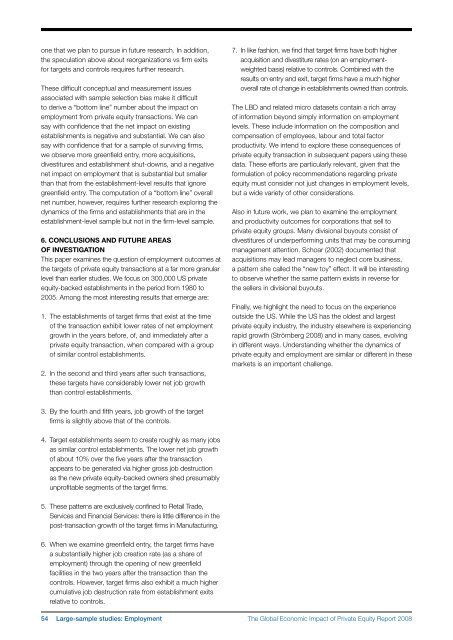The Global Economic Impact of Private Equity Report 2008 - World ...
The Global Economic Impact of Private Equity Report 2008 - World ...
The Global Economic Impact of Private Equity Report 2008 - World ...
- No tags were found...
You also want an ePaper? Increase the reach of your titles
YUMPU automatically turns print PDFs into web optimized ePapers that Google loves.
one that we plan to pursue in future research. In addition,the speculation above about reorganizations vs firm exitsfor targets and controls requires further research.<strong>The</strong>se difficult conceptual and measurement issuesassociated with sample selection bias make it difficultto derive a “bottom line” number about the impact onemployment from private equity transactions. We cansay with confidence that the net impact on existingestablishments is negative and substantial. We can alsosay with confidence that for a sample <strong>of</strong> surviving firms,we observe more greenfield entry, more acquisitions,divestitures and establishment shut-downs, and a negativenet impact on employment that is substantial but smallerthan that from the establishment-level results that ignoregreenfield entry. <strong>The</strong> computation <strong>of</strong> a “bottom line” overallnet number, however, requires further research exploring thedynamics <strong>of</strong> the firms and establishments that are in theestablishment-level sample but not in the firm-level sample.6. Conclusions and future areas<strong>of</strong> investigationThis paper examines the question <strong>of</strong> employment outcomes atthe targets <strong>of</strong> private equity transactions at a far more granularlevel than earlier studies. We focus on 300,000 US privateequity-backed establishments in the period from 1980 to2005. Among the most interesting results that emerge are:1. <strong>The</strong> establishments <strong>of</strong> target firms that exist at the time<strong>of</strong> the transaction exhibit lower rates <strong>of</strong> net employmentgrowth in the years before, <strong>of</strong>, and immediately after aprivate equity transaction, when compared with a group<strong>of</strong> similar control establishments.2. In the second and third years after such transactions,these targets have considerably lower net job growththan control establishments.7. In like fashion, we find that target firms have both higheracquisition and divestiture rates (on an employmentweightedbasis) relative to controls. Combined with theresults on entry and exit, target firms have a much higheroverall rate <strong>of</strong> change in establishments owned than controls.<strong>The</strong> LBD and related micro datasets contain a rich array<strong>of</strong> information beyond simply information on employmentlevels. <strong>The</strong>se include information on the composition andcompensation <strong>of</strong> employees, labour and total factorproductivity. We intend to explore these consequences <strong>of</strong>private equity transaction in subsequent papers using thesedata. <strong>The</strong>se efforts are particularly relevant, given that theformulation <strong>of</strong> policy recommendations regarding privateequity must consider not just changes in employment levels,but a wide variety <strong>of</strong> other considerations.Also in future work, we plan to examine the employmentand productivity outcomes for corporations that sell toprivate equity groups. Many divisional buyouts consist <strong>of</strong>divestitures <strong>of</strong> underperforming units that may be consumingmanagement attention. Schoar (2002) documented thatacquisitions may lead managers to neglect core business,a pattern she called the “new toy” effect. It will be interestingto observe whether the same pattern exists in reverse forthe sellers in divisional buyouts.Finally, we highlight the need to focus on the experienceoutside the US. While the US has the oldest and largestprivate equity industry, the industry elsewhere is experiencingrapid growth (Strömberg <strong>2008</strong>) and in many cases, evolvingin different ways. Understanding whether the dynamics <strong>of</strong>private equity and employment are similar or different in thesemarkets is an important challenge.3. By the fourth and fifth years, job growth <strong>of</strong> the targetfirms is slightly above that <strong>of</strong> the controls.4. Target establishments seem to create roughly as many jobsas similar control establishments. <strong>The</strong> lower net job growth<strong>of</strong> about 10% over the five years after the transactionappears to be generated via higher gross job destructionas the new private equity-backed owners shed presumablyunpr<strong>of</strong>itable segments <strong>of</strong> the target firms.5. <strong>The</strong>se patterns are exclusively confined to Retail Trade,Services and Financial Services: there is little difference in thepost-transaction growth <strong>of</strong> the target firms in Manufacturing.6. When we examine greenfield entry, the target firms havea substantially higher job creation rate (as a share <strong>of</strong>employment) through the opening <strong>of</strong> new greenfieldfacilities in the two years after the transaction than thecontrols. However, target firms also exhibit a much highercumulative job destruction rate from establishment exitsrelative to controls.54 Large-sample studies: Employment<strong>The</strong> <strong>Global</strong> <strong>Economic</strong> <strong>Impact</strong> <strong>of</strong> <strong>Private</strong> <strong>Equity</strong> <strong>Report</strong> <strong>2008</strong>















